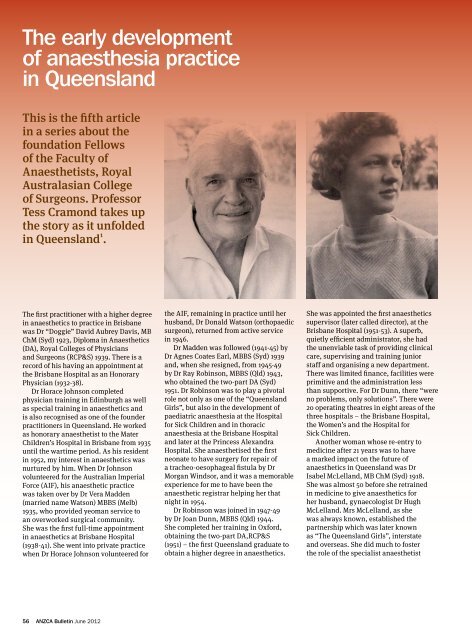ANZCA Bulletin June 2012 - final.pdf - Australian and New Zealand ...
ANZCA Bulletin June 2012 - final.pdf - Australian and New Zealand ...
ANZCA Bulletin June 2012 - final.pdf - Australian and New Zealand ...
- No tags were found...
Create successful ePaper yourself
Turn your PDF publications into a flip-book with our unique Google optimized e-Paper software.
The early developmentof anaesthesia practicein Queensl<strong>and</strong>This is the fifth articlein a series about thefoundation Fellowsof the Faculty ofAnaesthetists, RoyalAustralasian Collegeof Surgeons. ProfessorTess Cramond takes upthe story as it unfoldedin Queensl<strong>and</strong> 1 .The first practitioner with a higher degreein anaesthetics to practice in Brisbanewas Dr “Doggie” David Aubrey Davis, MBChM (Syd) 1923, Diploma in Anaesthetics(DA), Royal Colleges of Physicians<strong>and</strong> Surgeons (RCP&S) 1939. There is arecord of his having an appointment atthe Brisbane Hospital as an HonoraryPhysician (1932-38).Dr Horace Johnson completedphysician training in Edinburgh as wellas special training in anaesthetics <strong>and</strong>is also recognised as one of the founderpractitioners in Queensl<strong>and</strong>. He workedas honorary anaesthetist to the MaterChildren’s Hospital in Brisbane from 1935until the wartime period. As his residentin 1952, my interest in anaesthetics wasnurtured by him. When Dr Johnsonvolunteered for the <strong>Australian</strong> ImperialForce (AIF), his anaesthetic practicewas taken over by Dr Vera Madden(married name Watson) MBBS (Melb)1935, who provided yeoman service toan overworked surgical community.She was the first full-time appointmentin anaesthetics at Brisbane Hospital(1938-41). She went into private practicewhen Dr Horace Johnson volunteered forthe AIF, remaining in practice until herhusb<strong>and</strong>, Dr Donald Watson (orthopaedicsurgeon), returned from active servicein 1946.Dr Madden was followed (1941-45) byDr Agnes Coates Earl, MBBS (Syd) 1939<strong>and</strong>, when she resigned, from 1945-49by Dr Ray Robinson, MBBS (Qld) 1943,who obtained the two-part DA (Syd)1951. Dr Robinson was to play a pivotalrole not only as one of the “Queensl<strong>and</strong>Girls”, but also in the development ofpaediatric anaesthesia at the Hospitalfor Sick Children <strong>and</strong> in thoracicanaesthesia at the Brisbane Hospital<strong>and</strong> later at the Princess Alex<strong>and</strong>raHospital. She anaesthetised the firstneonate to have surgery for repair ofa tracheo-oesophageal fistula by DrMorgan Windsor, <strong>and</strong> it was a memorableexperience for me to have been theanaesthetic registrar helping her thatnight in 1954.Dr Robinson was joined in 1947-49by Dr Joan Dunn, MBBS (Qld) 1944.She completed her training in Oxford,obtaining the two-part DA,RCP&S(1951) – the first Queensl<strong>and</strong> graduate toobtain a higher degree in anaesthetics.She was appointed the first anaestheticssupervisor (later called director), at theBrisbane Hospital (1951-53). A superb,quietly efficient administrator, she hadthe unenviable task of providing clinicalcare, supervising <strong>and</strong> training juniorstaff <strong>and</strong> organising a new department.There was limited finance, facilities wereprimitive <strong>and</strong> the administration lessthan supportive. For Dr Dunn, there “wereno problems, only solutions”. There were20 operating theatres in eight areas of thethree hospitals – the Brisbane Hospital,the Women’s <strong>and</strong> the Hospital forSick Children.Another woman whose re-entry tomedicine after 21 years was to havea marked impact on the future ofanaesthetics in Queensl<strong>and</strong> was DrIsabel McLell<strong>and</strong>, MB ChM (Syd) 1918.She was almost 50 before she retrainedin medicine to give anaesthetics forher husb<strong>and</strong>, gynaecologist Dr HughMcLell<strong>and</strong>. Mrs McLell<strong>and</strong>, as shewas always known, established thepartnership which was later knownas “The Queensl<strong>and</strong> Girls”, interstate<strong>and</strong> overseas. She did much to fosterthe role of the specialist anaesthetist56 <strong>ANZCA</strong> <strong>Bulletin</strong> <strong>June</strong> <strong>2012</strong>
















